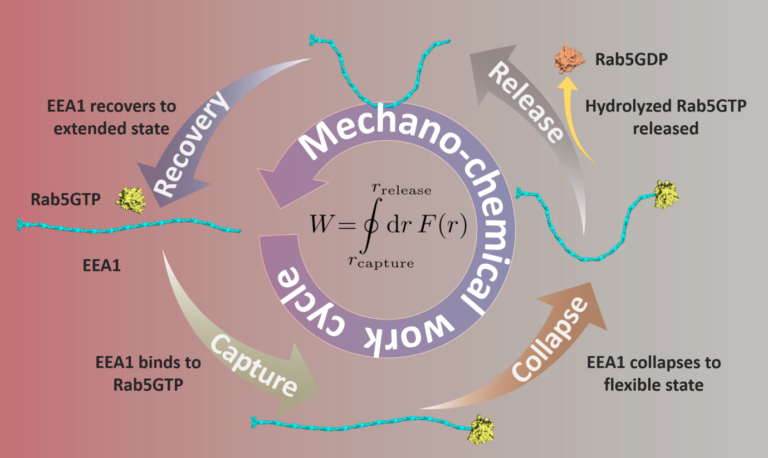Molecular engine powered by alternative fuel
Work done in the lab of Prof. Shashi Thutupalli at National Centre for Biological Sciences-Tata Institute of Fundamental Research, Bangalore
Anupam Singh graduated from BITS-Pilani with a bachelor’s degree in pharmacy. Shortly after graduation, he joined Dr. Meher K Prakash at JNCASR to hone his skills in theory and simulation. As his academic career progressed, he wanted to work in a lab that combined the best of both worlds – wet lab and theory. Therefore, he joined Dr. Shashi Thutupalli’s group at NCBS to pursue his PhD. Currently, he is a postdoctoral fellow at MPI-CBG, working in Prof. Marino Zerial’s lab to learn the art of molecular and cell biology. Privately, he most enjoys weekend projects that combine art and creativity with science, from building terrariums to museum projects.

Author Interview
How would you explain your research outcomes to the non-scientific community?
A cell is like a city that needs energy to perform its functions. The cellular fuels adenosine triphosphate (ATP) and guanosine triphosphate (GTP) provide energy to carry out cellular functions. Many cellular machines such as molecular motors and signaling molecules make use of this energy. Classically, molecular motors perform mechanical work using ATP as a biological fuel, much like oil for vehicles on roads carrying cargo. However, sources such as GTP have only been associated with signalling in the cell, which is equivalent to electricity in telecommunications and traffic signals in the city. Our experimental measurements and theoretical calculations have identified a molecular motor powered by the alternative fuel GTP. This molecular motor acts like a crane that pulls its two ends together to bring cell organelles closer together. This newly identified class of molecular motors and the alternative fuel they use are the first step toward further identification of such a class of molecular motors that may be involved in many other cellular functions.

“This newly identified class of molecular motors and the alternative fuel they use are the first step toward further identification of such a class of molecular motors that may be involved in many other cellular functions. “
How do these findings contribute to your research area?
The identified GTP-driven molecular motors brought a paradigm shift in our thinking about biological molecular motors. Unlike classical motors driven by a single molecular component, this newly discovered molecular motor consists of two units that embed specificity into the system. The two components, a long coiled-coil tethering protein EEA1 and a small GTPase Rab5, bind to each other and pull the two ends of EEA1 together. A thorough search revealed that there are numerous such pairs, located on different cell organelles, and their mechanistic effects have not yet been deciphered. The predicted role of these long coiled-coil proteins was limited to tethering. However, our research reveals a new mechanistic aspect of such protein pairs. We therefore anticipate that a new class of molecular motors will emerge in the future.
What was the exciting moment during your research?
It is always difficult to define an exciting moment. As researchers, we are constantly faced with setbacks, so every small success is a cause for celebration. However, there is one event that stands out in particular. For a long time, I was optimizing a technique to measure the change in flexibility of the EEA1. One day, when I was talking to my friend Joan (co-author of the paper) about his work and the labelling of EEA1, he mentioned the problem of labelling efficiency. Hearing this, I suggested using fluorescence correlation spectroscopy to measure labelling efficiency. We both went to the microscope and made measurements that yielded labelling efficiency, along with the solution to my long-standing problem of measuring the change in flexibility. This was the turning point in our research on measuring flexibility changes in proteins using fluorescently labelled protein ends. This technological advancement led to the discovery of GTP-driven molecular motors.
What do you hope to do next?
While working on these fundamental aspects, I am making advances in cell biology and biophysics to elucidate the role of mechanical forces in organelle fusions. I am developing techniques and methods to understand the phenomenon at the nanometer scale and to generate piconewton forces.
Where do you seek scientific inspiration from?
I admire nature because it finds solutions in the most unexpected ways. The mechanisms and underlying principles inspire me the most. I often find myself trying to understand these phenomena that operate at different levels. In my scientific journey, I want to understand these underlying principles and find their application in solving real-world problems.
How do you intend to help Indian science improve?
As an Indian science community, we have to work on many fronts. The biggest challenges are the lack of availability of resources and the lower application of the knowledge created. In short, we need an Indian industrial complex that supports its own science and technology. Likewise, scientific techniques and discoveries need to be incorporated into industry to promote growth and benefit society. So, I want to contribute by turning this wheel to create an inflow from industry and an outflow of technology into industry.
Reference: Singh, A., Soler, J.A., Lauer, J. et al. Two-component molecular motor driven by a GTPase cycle. Nat. Phys.19, 1185–1192 (2023). https://doi.org/10.1038/s41567-023-02009-3
Edited by: Nikita Nimbark
Biopatrika: Bringing Science to Society
© Biopatrika 2023 All Rights Reserved.